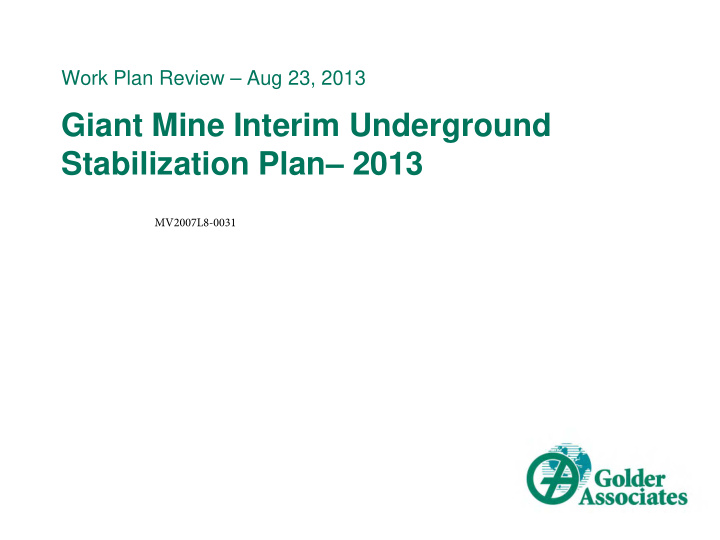



MV2007L8-0031 Work Plan Review – Aug 23, 2013 Giant Mine Interim Underground Stabilization Plan– 2013
Mitigation Sequence Strategy A phased mitigation sequence that addresses previously identified geotechnical hazard priority but also recognizes that in some areas we need to understand the situation better before we can develop a detailed plan. Mitigate high risk non-arsenic stopes with good knowledge base and 1. ease of underground access: 1-18. Develop a parallel / contingency plan to partly mitigate moderate risk 2. non-arsenic stopes with good knowledge base and ease of access: C3- 12/C5-09. This area provides a good area for commissioning of paste equipment with few environmental challenges and an alternate fill placement area when needed. Optimize approach and prepare to mitigate high risk non-arsenic stopes 3. with some data gaps and some underground access challenges: B3- 06 . December 16, 2013 2
High Priority Areas With Reasonable Knowledge 1) 1-18 Non-Arsenic Stope Under Baker Creek 2) C3-12/5-09 Non- Arsenic Stope Under Arsenic Stope C2-12 and Arsenic Chamber 9 3) B3-06 Non-Arsenic Stope Under Arsenic Stope B2-08 December 16, 2013 3
Main Elements of Mitigation Plan Excavate tailings and stockpile near B1 pit 1. Drill surface backfill, paste delivery, monitoring, breather boreholes 2. Rehabilitate underground ground control system as needed 3. Drill underground backfill, inspection, monitoring, breather boreholes 4. Install underground paste delivery piping system 5. Construct underground fill barricades 6. Produce paste and pump underground to backfill voids 7. December 16, 2013 4
1. Tailings excavation and stockpiling Excavate from South Tailings pond by pulling top few m’s which are anticipated to be lower moisture content and trafficable with heavy equipment. Create mini-stockpiles near B1 pit working area for use during paste production. Truck Wash Replenish mini-stockpile by direct digging from South Tailings pond as needed. Mini Stockpiles December 16, 2013 5
2. Surface Drilling Surface boreholes required for: Direct placement of backfill into stope voids. Remote placement of fill barricade (where required) Delivery of paste to underground boreholes (via. pipe) Inspection and monitoring (borehole cameras) Breather holes December 16, 2013 6
3. Underground support rehabilitation C&M contractor currently only maintains minimal underground development openings according to the NWT Mine Health and Safety Act and Regulations. A process to assess hazards for re-entry into old mining areas, documentation of that process, and maps describing where staff and mining equipment can / can’t go is required prior to development of detailed plans for backfilling of each stope. December 16, 2013 7
4. Underground drilling Underground drilling into voids that cannot be intersected reasonably from surface required for: Direct placement of backfill. Remote placement of fill barricade (where required) Delivery of paste to underground boreholes (via. pipe) Inspection and monitoring (borehole cameras) Breather holes December 16, 2013 8
5. Underground paste delivery piping system In some cases drilling boreholes from surface directly into the targeted void to be backfilled may not be possible, safe, or environmentally sound. Voids under arsenic stopes. Voids under Baker Creek (e.g. 1-18 stope Upper) Etc. Vertical boreholes will be drilled to safely accessible underground openings, piped underground, and pumped into voids through underground drillholes. December 16, 2013 9
6. Underground fill barricade construction Once ground support is up-to-date, fill fences can be installed. Barricades do not need to be completely tight to the back and ~ 90-95% closure of the cross-sectional area of the openings is likely sufficient. Paste backfill delivery hole Void to be Rockfill barricades placed directly backfilled where machine accessible, and low slump barricades delivered via. borehole where safe access not available or practical. Placed lightly cemented tailings paste backfill Existing rockfill December 16, 2013 10
6. Underground fill barricade construction Borehole emplaced barricades do not need to be completely tight to the back and ~ 90-95% closure of the cross-sectional area of the openings is likely sufficient. Low slump paste Similar to those attempted for FOS with concrete, but using cemented paste. Expanding foam barricades. December 16, 2013 11
7. Produce paste tailings and pump underground Produce Paste and Place It Underground Monitor Filling Success Using Camera’s and Cavity Surveys in Boreholes and Placed Underground Show Video December 16, 2013 12
Field Fill Barricade and Paste Test We need to test some elements of the mitigation plan to allow for final engineering and implementation. Proposed Paste Mixes Field Test Drift Barricades Area, South Main Giant Mine Tailings Infrastructure Complex Pond December 16, 2013 13
Mitigation Plan for 1-18 Stope December 16, 2013 14
Recommend
More recommend